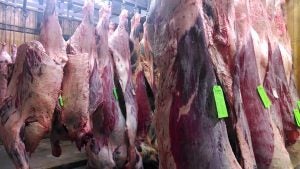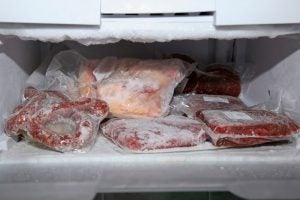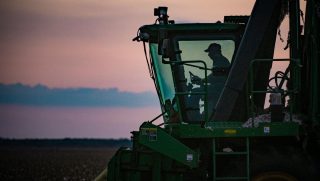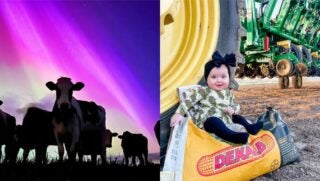May is recognized as National Beef Month! With that in mind, I want to talk about buying beef directly from the farmer, which can seem like a daunting task if you’ve never done it before.
Most ranchers will be more than happy to walk you through the process, from how much you will pay and to whom, to how to cut it to provide you optimal satisfaction and about how much meat you will get. It can feel like a lot of money, but with financial planning, you will find that it can save you a lot of money over the long term.
“What is it going to cost?”, and “How much meat am I going to get?”, are always the first questions we receive. Let’s break it down.
Disclaimer: These are all rough numbers based on the time of writing. These numbers are subject to change based on location, rancher, market fluctuations, breed of animal, processor cost, specific cuts requested, among other things. But hopefully this will serve as a good guideline to initiate you.
How much meat will I receive?
When buying bulk beef, most sell by quarter, half, or whole. On average a beef animal will be finished when they weigh between 1,200 and 1,400 pounds. However, you don’t get quarter, half, or whole of the finished weight. Beef dresses around 60 percent to 62 percent of the finished weight. “Dressed weight” means the processor has taken off the parts that you won’t be consuming (but it is probably getting processed to be used for some other products like leather, crayons, soap, Band-Aids, toothpaste, or glue).
Depending on the processor, beef hangs for 2 or more weeks to develop flavor and naturally tenderizes the meat. Dressed weight can also be called hanging weight or carcass weight.

Therefore, using 1,300 pounds as an average and dressing at 61 percent:
- 1/4 of beef = 198.25 pounds of beef
- 1/2 of beef = 396.5 pounds of beef
- Whole beef = 793 pounds of beef
Keep in mind, depending on how you have it cut, there will be bones included in this weight, so it won’t all be meat.
How much will it cost?
There are a couple of ways that you may be charged. Some ranchers will bundle the cost of the animal and processing together. Others will take only the cost of the animal, and the individual buying the meat will settle up on the processing with the processor. This may be directly related to the rules and regulations set up in your state. Many states won’t allow people to take beef from the processor home to their freezer unless you have certifications and random checks from an inspector. Regardless, the amount should be the same or close.
As of writing, in my location in Kansas, $1.82 per pound is the market price for a finished steer or heifer. Using the average of 1,300 pounds for finished means that animal (only the animal not the processing) is worth $2,366.
Now about the processing: I cannot stress enough, these are rough numbers and will vary based on a variety of factors, but let’s use $0.70 to $0.90 per pound processing cost. Custom processors can charge differently based on their experience, but a general rule is that the $0.70 to $0.90 per pound will be charged on the hanging weight. If you choose to get things cured or smoked ($1 per pound to $1.85 per pound), summer sausage or beef sticks ($2 per pound to $7 per pound), hamburger patties ($0.60 per pound to $1.50 per pound), there will be additional charges based on the weight that you choose to do that particular cut with. These vary widely based on the processor. The examples I have given are off custom processor websites in my home state.
Additional charges processors can charge is a slaughter fee ($80 to $100 per animal), a disposal fee, or a splitting fee for separating the animal in to multiple orders (quarters or halves).

Therefore, using $0.80 per pound and $90 a slaughter fee as a baseline for processing, at the minimum, processing costs would be …
- 1/4 beef is $158.60 + $22.50 = $181.10
- 1/2 beef is $317.20 + $45 = $362.20
- Whole beef is $634.40 + $90 = $724.40
When we add the animal cost with the processing cost…
- 1/4 beef is $181.10 + $591.50 = $772.60
- 1/2 beef is $362.20 + $1,183 = $1545.20
- Whole beef is $724.40 + $2,366 = $3,090.40
Remember that we chose the baseline of the processing cost. While making patties seems like an unneeded extra cost, think about whether on those busy nights, if already having the patties made will ensure you cooking the patties. Whereas, if they weren’t made, you would go through the drive through lane instead. While we can all make our own patties or tenderize certain cuts, what is it worth it to have the processor do it for you?
The average would be $3.85 per pound. Keep in mind this is across all cuts from ground beef to filet steaks. Most ranchers are going to do a discount when buying a whole. Therefore, they may increase the price for a quarter and half. Or they may not. It depends on how the ranch is set up.
So while it sounds like a lot up front, it evens out to less per pound than buying certain cuts from the store. Just know that if you can’t afford buying beef in bulk, doesn’t mean the meat in the grocery store is any less nutritious or healthy for your family. The same family farms that sell meat directly to the consumer is also the family farm that supplies the supermarket with beef. This isn’t a question of nutritional value, the product is the same.
Kelsey Pagel is a Kansas farmer. She grew up on a cow/calf and row crop operation and married into another. Kelsey and her Forever (Matt) farm and ranch with his family where they are living their dream and loving most of the moments.


